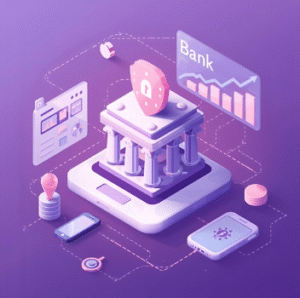Introduction to Digital Banking
The landscape of banking in the USA is shifting dramatically as digital solutions redefine traditional practices. Digital banking leverages technology to offer services that are faster, more efficient, and tailored to the demands of a modern, tech-savvy population. From managing accounts to completing transactions, digital tools have made banking activities more accessible and user-friendly than ever before.
Customers can now interact with their banks through online platforms and mobile applications, reducing the need for in-person visits. These digital interfaces provide a streamlined approach to managing finances, making it easier for individuals and businesses to stay in control of their money. As a result, the convenience of digital banking is driving higher levels of customer engagement across various demographics.

Unlike traditional banking, which often involved time-consuming processes, digital banking eliminates many of the inefficiencies that once frustrated customers. Whether it’s transferring funds, paying bills, or monitoring spending habits, digital tools provide quick, seamless solutions to everyday financial tasks. The use of mobile devices has particularly accelerated this transition, enabling banking to fit seamlessly into the busy schedules of today’s consumers.
Furthermore, digital banking is continuously evolving, with new innovations designed to improve usability and expand capabilities. These advancements cater to the needs of a generation that prioritizes both speed and simplicity in their financial interactions. By incorporating these technologies into their services, banks are not only meeting customer demands but also setting the stage for the future of finance in the country.
Technological Advancements Driving Change
Technological progress is reshaping the way financial institutions operate, introducing tools that simplify and enhance the customer experience. Artificial intelligence (AI) and machine learning (ML) are driving many of these changes by offering predictive insights and enabling more efficient processes. These tools allow banks to understand customer behaviors and preferences in ways that were not possible before, leading to more tailored solutions and services. For example, AI-powered tools can detect patterns in spending or saving habits, helping customers make smarter financial decisions.
Voice recognition technology is another innovation gaining traction, allowing users to manage accounts and perform transactions through voice commands. This feature provides convenience for individuals who prefer hands-free interactions or need an accessible option for managing their finances. Additionally, the integration of real-time data analytics ensures that users receive up-to-date information about their accounts, helping them stay informed and make timely decisions.
Blockchain is emerging as a potentially transformative technology in the banking sector, particularly in areas such as secure payment systems and fraud prevention. Its decentralized nature offers a higher level of transparency and reliability, reducing the risks associated with traditional transaction methods. While the adoption of blockchain is still evolving, its potential applications within banking are being closely explored by financial institutions.

Another major development is the use of biometric authentication methods. Technologies like fingerprint scans, facial recognition, and iris scanning are becoming more widespread, offering enhanced security for digital transactions. These methods reduce reliance on passwords and PINs, which can be easily forgotten or compromised, and provide users with a more seamless login process.
Advancements in cloud computing are also enabling banks to scale their operations while maintaining data security. By leveraging the cloud, banks can process and store massive amounts of information more efficiently, ensuring a smoother experience for both customers and employees. This technology also supports the rapid deployment of new features and updates, ensuring services remain current with evolving demands.
Lastly, the Internet of Things (IoT) is beginning to influence the financial sector, connecting smart devices to banking systems for even greater convenience. Smartwatches and other wearable technology now enable users to check balances or receive alerts, bringing financial management to the forefront of everyday life.
Changing Consumer Expectations
The evolution of technology in banking has prompted a shift in what customers want from their financial institutions. Increasingly, consumers value services that are not only fast but also intuitive. They expect platforms that work seamlessly, minimizing delays and technical difficulties. A smooth user experience on mobile and desktop platforms has become a critical factor in customer satisfaction, pushing banks to prioritize interface design and functionality.
One key expectation is for personalized services that align with individual financial goals and preferences. Customers want banks to use the data they already have to create tailored experiences, such as customized budgeting tools, spending insights, and offers that are specific to their needs. These tailored services make financial management more relevant and practical, fostering deeper trust between banks and their customers.
Transparency is another growing demand from consumers. With access to extensive information, customers now expect clear explanations regarding fees, terms, and services. They want to feel confident that they understand the full scope of their financial decisions without encountering hidden costs or unclear policies.

Additionally, there’s a noticeable preference for self-service options. Many customers would rather handle straightforward tasks on their own through user-friendly platforms than rely on in-person assistance. For more complex financial matters, however, they still expect immediate access to knowledgeable support, whether through live chat, video calls, or phone consultations. This balance between automation and human support is becoming increasingly important.
Speed is non-negotiable when it comes to services like fund transfers, loan approvals, and account setups. The ability to complete these processes quickly and efficiently is a major factor influencing customer satisfaction and loyalty. Delays or cumbersome procedures can lead to frustration, making it crucial for banks to refine their operations.
Lastly, sustainability is beginning to play a role in shaping consumer expectations. Environmentally conscious customers are looking for financial institutions that align with their values, whether by offering green investment options or adopting eco-friendly practices in their operations. This trend indicates a broader shift in how people view the role of banks in contributing to global and social well-being.
Security and Privacy Concerns
The transition to digital banking has brought a heightened focus on safeguarding user data, as the reliance on technology introduces new vulnerabilities. Financial institutions are investing heavily in advanced tools to detect and prevent unauthorized access to sensitive information. For instance, encryption ensures that data remains secure during transmission, while multi-factor authentication adds an extra layer of protection by requiring multiple forms of verification before granting access.
Biometric authentication, such as fingerprint and facial recognition, has also become a key component of securing digital interactions. Unlike traditional passwords, which can be forgotten or stolen, these technologies provide a more robust and convenient way for customers to verify their identities. However, the use of biometrics has sparked discussions about the ethical handling of personal data and the potential risks if such information were to be compromised.
Despite these measures, the rapidly changing landscape of cyber threats poses ongoing challenges. Hackers continue to develop sophisticated methods for exploiting vulnerabilities, requiring banks to stay ahead with regular updates to their security protocols. Phishing schemes, malware attacks, and identity theft remain persistent threats, emphasizing the importance of customer education alongside technical solutions. Banks are increasingly providing resources to help users identify and avoid common scams, empowering them to take an active role in protecting their accounts.

The integration of artificial intelligence is playing a significant role in threat detection, with AI systems monitoring transactions in real time to flag suspicious activity. These systems analyze patterns and anomalies to identify potential risks, often preventing fraud before it occurs. However, as these technologies evolve, concerns about false positives and the accuracy of automated systems remain important considerations.
As banks adopt cloud-based infrastructure to improve efficiency, the security of stored data has become another critical focus. Institutions must strike a balance between leveraging the flexibility of cloud solutions and ensuring compliance with stringent data protection regulations. Partnerships with third-party cloud providers require rigorous oversight to maintain the integrity and confidentiality of customer information.
Lastly, the rise of open banking, which allows third-party providers to access financial data through secure APIs, introduces new privacy considerations. While this innovation offers convenience and expanded services, it also requires careful management of data-sharing practices to protect against potential misuse.
Impact on Financial Inclusion
Digital banking is playing a vital role in expanding financial services to individuals and communities that have traditionally been left out of the formal banking system. By offering affordable and easily accessible options through mobile apps and online platforms, banks are reducing barriers that once made it difficult for people in underserved areas to participate in financial activities. This shift is particularly significant for individuals without easy access to physical bank branches or those who face economic challenges that limit their ability to open and maintain traditional accounts.
For many low-income individuals, digital banking offers solutions tailored to their needs. For instance, banks can now provide tools like small-scale loans, savings accounts with no minimum balance requirements, and payment systems that bypass the need for costly intermediaries. These offerings enable people to manage their finances without incurring high fees or navigating complex procedures, creating opportunities for financial stability and growth.
Technology also empowers smaller businesses, entrepreneurs, and gig workers by streamlining payments and providing access to credit. Digital banking platforms can assess creditworthiness using alternative data, such as transaction histories or payment behaviors, making it possible for those without formal credit histories to qualify for loans and financial services. This not only supports individual financial independence but also strengthens local economies by fostering small-scale enterprises.

Another way digital transformation contributes to financial inclusion is through enhanced financial literacy. Mobile and online banking platforms often include educational tools designed to help users understand budgeting, saving, and investing. These resources can empower people to make informed financial decisions, enabling them to break cycles of economic vulnerability.
Additionally, advances in technology make it easier for banks to reach remote areas where traditional infrastructure may be limited. The widespread adoption of mobile phones means even individuals in rural regions can connect to digital banking services. This accessibility reduces the need for physical banking locations and creates opportunities for financial institutions to serve a broader audience without the associated overhead costs.
By incorporating language options, simplified interfaces, and customer support tailored to diverse demographics, digital banking is addressing specific needs while fostering inclusion across economic, geographic, and cultural lines.
Future Trends in Banking
The banking industry in the USA is on the verge of significant advancements as emerging technologies continue to redefine how financial services are delivered. One prominent area of focus is the growing role of automation and artificial intelligence in providing customers with personalized financial insights. As AI algorithms become more advanced, banks will be able to offer tailored recommendations for budgeting, saving, and investing, helping individuals and businesses make better financial decisions effortlessly.
Another area gaining momentum is the increased adoption of decentralized finance (DeFi). DeFi platforms leverage blockchain technology to enable direct, peer-to-peer transactions without relying on traditional intermediaries like banks. This shift could lead to new opportunities for customers to access loans, investment products, and other services with reduced fees and greater transparency.
The rise of smart devices and interconnected ecosystems is also expected to influence banking trends. For example, the integration of financial services with smart home systems or wearable technology could allow customers to make payments, monitor accounts, or receive financial updates through everyday devices. This connectivity is likely to enhance convenience and further embed financial management into daily life.

Sustainability will likely become a key driver of future banking initiatives. As more customers demand environmentally responsible practices, banks are expected to adopt greener strategies, such as offering eco-friendly investment options or reducing the environmental footprint of their operations. This alignment with sustainability goals not only addresses consumer expectations but also reflects a growing societal emphasis on environmental responsibility.
Finally, open banking is set to expand, with increased collaboration between banks and third-party service providers through secure data-sharing agreements. This approach allows customers to benefit from a broader range of services, such as innovative financial management tools or advanced payment solutions, all while maintaining control over their data.
The evolution of these trends underscores the importance of innovation and adaptability within the banking sector. By embracing these changes, financial institutions can continue to deliver valuable services that meet the needs of an increasingly tech-driven and socially conscious population.


